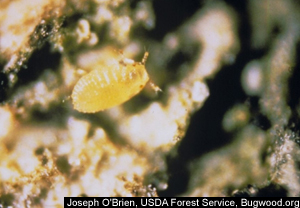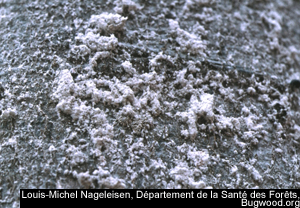
A beech bark scale nymph
LANSING — In the dead cold of the Upper Peninsula winter, Robert Heyd leaves his snowmobile and approaches an enormous American beech armed with a slingshot, rope and a saw.
Supported by his snowshoes on four feet of snow, Heyd slings a quarter-pound weight attached to parachute cord 80 feet up into the highest branches of the behemoth and uses the rope to haul the 4-foot saw to the top.
A branch falls harmlessly to the ground next to the Department of Natural Resources (DNR) forest health management program director.
It’s a first step in saving the state’s majestic beeches.
After eight years of research, the DNR and the U.S. Forest Service are ready to implement a strategy to fight the destructive beech bark disease, said Jennifer Koch, a research biologist with the Forest Service’s Northern Research Station in Delaware, Ohio.
Koch said the strategy will plant trees that are naturally resistant to the disease in seedling orchards throughout the state to increase the likelihood of resistant trees multiplying.
The DNR identified nine disease-resistant types of beeches in the Lower Peninsula and 19 in the U.P., Koch said. Still, those trees are too spread out to naturally multiply before the beech population is devastated.
“We’re basically just trying to help Mother Nature by putting the resistant trees next toeach other,” Koch said. “When you plant them all together, they have no choice but to cross with each other.”
Koch said the first seedlings for planting in the orchards are being grown and will be planted this fall.
The branches that Heyd collects from a resistant tree are the starting point for creating disease-resistant seedlings. Those branches travel to Koch’s laboratory where they are grafted and later produce seeds.
Koch said the seedlings have a 50 percent chance of being disease-resistant, while only 1-5 percent of seedlings in the wild are resistant.
Heyd said it’s a good solution to a big problem.
“Once the disease is in the state, it’s very difficult to get it out,” Heyd said.
Patrick Rusz, the Michigan Wildlife Conservancy’s director of wildlife, said the disease is caused by a tiny insect called a beech scale. The scale, which is less than 1/16 of an inch long, feeds on the sap, allowing deadly fungi to invade openings in the bark. The process kills the trees.
The invader species is thought to have come to North America on Asian ornamental trees in the late 19th century. It doesn’t work as fast as the better-known emerald ash borer but has been devastating to Michigan’s beech population.
For example, beeches in Ludington State Park, where the disease was first discovered in Michigan, have been ravaged.
Dan Flaherty, the park’s manager, said the dead trees can be dangerous, especially around campsites. At this point, there is little the park can do other than cut down the dead trees and plant different species.
“You do what you need to do to make those situations safe,” Flaherty said. “To replace a hardwood tree that might have been 60-80 years old and put in a 2 1/2 inch tree, you don’t have instant gratification.”
Flaherty said that reforesting is difficult because saplings often cost $150-$200 each. The park relies heavily on donations to support reforestation because there is little state money for that purpose.
Most of Michigan’s infected trees are in the northwest Lower Peninsula and the eastern U.P.
Heyd said it’s absolutely necessary to remove all the infested trees, especially where people may be present. Beech snap–when a tree suddenly breaks and falls–is a potential hazard to forest-users and structures, Heyd said.
Heyd said in the forests around Tahquamenon Falls, the DNR removes trees at the first sign of scale infestation. Removal and proper disposal of the diseased trees is the biggest difficulty in managing the disease, according to Heyd.
While the vast majority of beech in the state are falling victim, Koch said the planted orchards will start to replace those that die.
Koch said the resistant trees will eventually proliferate anyway.
“It’s a very slow process, but we’re able to accelerate that process with a little bit of intervention,” Koch said.
Koch stressed that the strategy creates more naturally resistant trees, not genetically-altered specimens.
“We are not doing genetic engineering,” Koch said. “This is not genetic manipulation.”
Despite the progress, Heyd predicted it will be a long time before the resistant trees become the dominant beech in Michigan.
“It’s not short term, it’s long term,” Heyd said. “But that’s what forestry is.”
Pingback: » Great Lakes Around the Web — April 13 — April 19, 2009 - Healthy Lakes - Healthy Lives